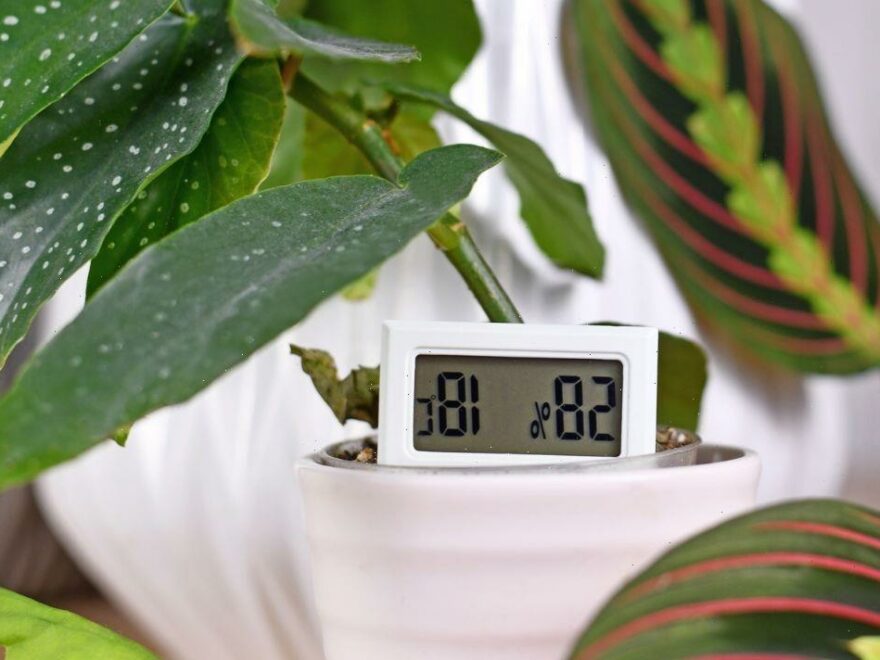Gardeners' World: How to care for houseplants
We use your sign-up to provide content in ways you’ve consented to and to improve our understanding of you. This may include adverts from us and 3rd parties based on our understanding. You can unsubscribe at any time. More info
After lighting, the temperature is the second most important factor affecting plant growth in houseplants. Many indoor plants hail from tropical or subtropical regions and don’t fare well in cold climates. This is one of the reasons for their popularity as houseplants; the temperatures inside most homes are ideal. Gardening experts at BackyardBoss have shared what the best temperature is to keep your houseplants thriving all-year round.
They said: “Temperatures can fluctuate quite a bit depending on a variety of factors such as the time of year and location within the home.
“Considering the temperature when picking a location for your houseplants is crucial for the health of your plants.”
How does temperature affect growth?
The plant pros noted: “Temperature and light work hand-in-hand to keep houseplants thriving. The process of photosynthesis requires sunlight, but wouldn’t be possible without desirable temperatures for plant growth.”
Temperature assists with respiration, breaking down the energy provided through photosynthesis.

Through the process of respiration, plants use stored oxygen and sugars, converting them into energy. The by-product is carbon dioxide and water.
The experts warned: “High temperatures will lead to increased respiration, water loss, and dehydration which can result in shrivelling.
“Low temperatures will decrease respiration which may result in stunted growth, foliage damage, leaf drop, or plant death. This is why it’s best to know the proper temperature requirements for your specific plant and to keep an eye on your thermostat.”
What temperature is too cold?
If temperatures drop below 10 degrees Celsius, this is usually too cold for most houseplants. The pros explained: “Brief periods of temperatures between five and 10 degrees may not be detrimental for all indoor plants, but most will not survive long spells in this range.”
DON’T MISS
Kitchen features that make homes look ‘small, cheap and outdated’ [EXPERT]
Dissolve ‘stubborn’ kettle limescale with just one kitchen staple [TIPS]
‘Game changer’ Use ‘amazing’ and cheap hack to prevent mould [COMMENT]
There are always exceptions to the rules; cast iron plants, ferns, cyclamen, and succulents, can all survive in lower temperatures, and some even prefer it. Succulents, for example, are often quite happy with nighttime temperatures of five degrees Celsius.
If you’re decorating a cooler area of your home, some of the best options are parlour palms, baby rubber plants, English ivy. However, most houseplants will not flourish in these cooler temperatures.
What is the best temperature for houseplants?
Homes are typically well above 10 degrees which houseplants will be more than happy with. The houseplant gurus said: “The best temperature for houseplants during the day is between 21 and 27 degrees. Most plants prefer temperatures 10 to 15 degrees cooler at night.
“The drop in temperature slows respiration rates which help with energy production. Flowering plants will benefit from temperatures as low as 12 to 15 degrees. The cooler temperatures help to extend the life of their blooms.

“Many houseplants will survive in ranges below 12 and above 27 degrees, but in some cases it can stunt their growth. Make sure you check on your plants growing needs to see what temperatures they prefer to avoid plant death.”
In the cooler months, insulating the pot, or using heat mats can help keep your plants warm. For plants exposed to prolonged periods of extreme heat, be sure to provide extra water to reduce stress.
Maintaining the ideal temperature for your houseplants
To maintain the ideal temperature for your houseplants, keep the thermostat at a level that you find comfortable and your plants should also be happy. For example, potted plants will do well in 18 to 24 degrees, while plants with more foliage can tolerate higher temperatures.
The plant experts said: “Setting your thermostat a few degrees cooler at night can also benefit some plants, but it isn’t necessary. Homes are often naturally cooler at night. Plants located near windows that receive direct light will experience warmer temperatures than plants set back from the windows. These window sill spots are perfect for flowering plants which benefit from a big drop in nighttime temperatures.

“Be careful about where you place your plants, and move them if necessary throughout the year to avoid blasts from the air conditioner or heating vents. In the winter months, you may need to move plants back slightly from windows to ensure that foliage isn’t touching the glass – the cold panes can damage the plant tissue.”
How humidity factors in
In tropical habitats and greenhouses where plants flourish, there is a higher level of moisture in the air than is typically provided in homes. Exceptions include succulents and cacti which live in an arid environment and prefer low humidity. Otherwise, houseplants will like a medium humidity level, between 40 and 50 percent, according to the experts.
They said: “Whether it’s a dry climate, or your space has drafts from air conditioners and heating units, the humidity in most homes is often low (especially in the winter). When this relative humidity is too low, it can lead to faster water loss, resulting in shrivelling leaves.
“You can increase the humidity around your plants by grouping them together, using humidifiers, and growing them in terrariums or glass cabinets. However, high relative humidity in combination with high heat can be detrimental to the health of your plants. When indoor temperatures climb above 30 degrees, this may rapidly dehydrate your plants.”
Source: Read Full Article
